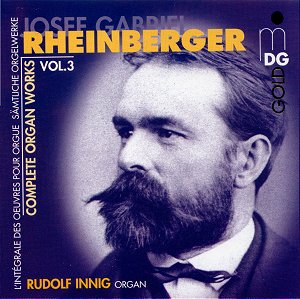RHEINBERGER
Complete Organ Works volume 3.
Sonata no. 5 in F sharp major.
Sonata no. 6 in E flat minor. 12 Fughettas.
 Rudolf Innig.
Rudolf Innig.
 MDG Gold MDG 317 0893-2
(DDD)
(63.49)
MDG Gold MDG 317 0893-2
(DDD)
(63.49)
Crotchet

How I remember cursing under my breath when trying to play these difficult
sonatas on our local and magnificent Father Willis organ. I used to pray
that the verger would put his vacuum cleaner on to cover up the wrong notes.
I was only 14 at the time but all these years on these sonatas are still
very demanding particularly these two which are in remote keys, so-called.
Very difficult to read at times let alone play.
I fell in love with the Second Sonata in A flat when I was a teenager perhaps
because the main theme of the opening movement was very similar to the hymn
tune St Anne set to that much maligned hymn O God our help in ages past.
I was very keen on a girl called Anne at that time who tried to convert me
to the rich orchestral scores of Tschaikovsky. She failed.... fortunately.
Bach wrote a Prelude and Fugue called St Anne and I could not play that very
well either.
Rheinberger's twenty organ sonatas were quite popular all those year ago
and Novello published them in an edition by Harvey Grace. His pedalling
instructions used to drive me wild.. They were impossible
The F sharp sonata dates from May 1878. Its grand opening is very reminiscent
of a church processional and the 32 foot pedal stop is truly marvellous.
The main section is a striking fugue but so very well written is it that
this academic device is lost in the compositional skills. The slow movement
is in two parts including a superb wistful theme and then an allegro section
before the original tempo reappears. While the material may not be outstanding
the logic and coherence of the work is evident. The movement makes sense;
it is never episodic and flabby. But that can be said of most, if not all,
of Rheinberger's music. The finale is an allegro maestoso with two
main subjects. Again the sound of this wonderful instrument cannot distract
from a church setting and in the perceived sense of a feeling of leaving
a service with euphoric peace with God is evident. The conclusion is rather
hymnic and this adds to the feelings I have about his piece.
As I have said in another review many people will not warm to this music
because of its religiosity. That would be unfair. The music is very strong,
rugged and tough but in the sense of its majesty not in unacceptability.
The B flat minor sonata dates from 1880 and, in my view, is an even greater
sonata. Its thematic material is more memorable. It is in four titled
movements... Prelude, Intermezzo, Marcia religiosa and the obligatory
Fugue. The prelude is very fine. I have often thought of orchestrating
it, not that I am a good orchestrator, but that it would make an impressive
opening to any concert. And there is a surprise in that there is a fugato
in the prelude. The music's intensity may be a little too much for some.
And discerning listeners will recognise that same intensity in the early
works of that great master, Arnold Schoenberg. The movement ends with an
unfortunate recording stutter on my copy. The intermezzo is intended to be
light relief and is in B major and simple ternary form. I do feel that Inning
makes it slightly heavy at times. In fact, I wish he would allow more contrast
of tone and registration throughout his performances. Marcia Religiosa
is a hybrid and rather daft title for any piece of music but this one is
very enjoyable and, occasionally impressive. Again ,
a variety of tone and registration would have helped. The finale is
a four part fugue, if I recall correctly, with a reference to the opening
movement. This time the academic device is not hidden and therefore the fugue
does sound mechanical.
The recital ends with the 12 Fughettas which have their origin in
the Sonata no. 8. They are very short and perhaps slightly trivial. Fugues
at best are mathematical. I did feel that this disc was primarily designed
to show the power of the organ and not the quality of the music. That it
is mostly played at a high volume and little registration changes gives the
music no respite and does deter from the music. It is rather like listening
to a stunning performance of a Violin Concerto and not commenting on the
performance or on the performer but the Stradivarius instrument that was
used.
Inning is a good player. But I wonder if the engineers have wanted to steal
the limelight.
For lovers of fine organs and those interested in Rheinberger's prestigious
talent this may well be worth investigating.
David Wright
Performances

Recording

